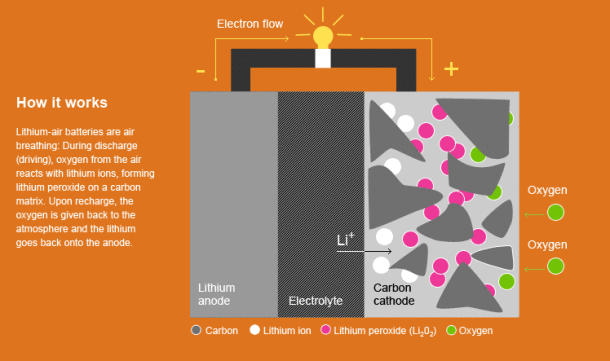
IBM: Lithium air battery to let electric cars outlast gas guzzlers
Volumatrix
ONE of the biggest drawbacks with owning an electric vehicle (EV) is range anxiety – a driver’s nagging fear that the battery charge will not get them to their destination. Now IBM claims to have solved a fundamental problem that may lead to the creation of a battery with an 800-kilometre (500-mile) range – letting EVs potentially compete with most petrol engines for the first time.
Standard electric vehicles use lithium-ion (Li-ion) batteries, which are bulky and rarely provide 160 kilometres (100 miles) of driving before they run down.
A newer type, known as a lithium-air cell, is more attractive because it has theoretical energy densities more than 1000 times greater than the Li-ion type, putting it almost on a par with gasoline. Instead of using metal oxides in the positive electrode, lithium-air cells use carbon, which is lighter and reacts with oxygen from the air around it to produce an electrical current.
But there’s a problem. Chemical instabilities limit their lifespan when recharging, making them impractical for use in cars, says physicist Winfried Wilcke at IBM’s Almaden laboratories, based in San Jose, California.
So Wilcke studied the underlying electrochemistry of these cells using a form of mass spectrometry. What he found was that oxygen is reacting not just with the carbon electrode, as it was known to, but also with the electrolytic solvent – the conducting solution that carries the lithium ions between the electrodes.

However, if the electrolyte reacts with the oxygen when the car is in use it will eventually be depleted. So, working with his colleague Alessandro Curioni at IBM’s Zurich research labs in Switzerland, Wilcke used a Blue Gene supercomputer to run extremely detailed models of the reactions to look for alternative electrolytes. This included a form of atomistic modelling right down to the quantum mechanics of the components, says Curioni.
“We now have one which looks very promising,” says Wilcke. He won’t reveal what material it is but says that several research prototypes have already been demonstrated. And as part of Battery 500, an IBM-led coalition involving four US national laboratories and commercial partners, the hope is to have a full-scale prototype ready by 2013, with commercial batteries to follow by around 2020.
If it works, this would solve a major obstacle with lithium-air batteries, says Phil Bartlett, head of electrochemistry at the University of Southampton, UK. There are other practical issues to address, such as enabling such batteries to cope with moist air. “Lithium in water spontaneously catches fire,” he points out.
(Source)
